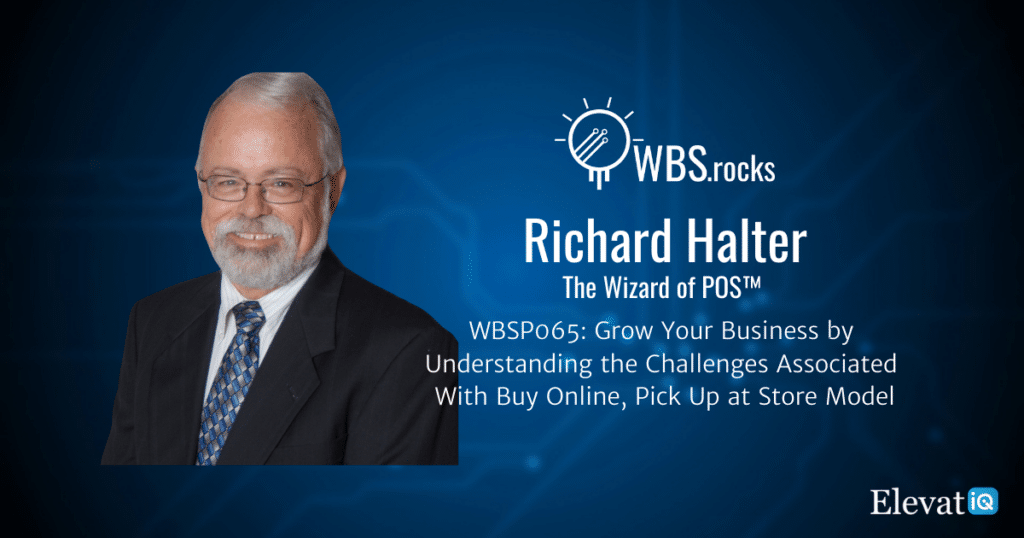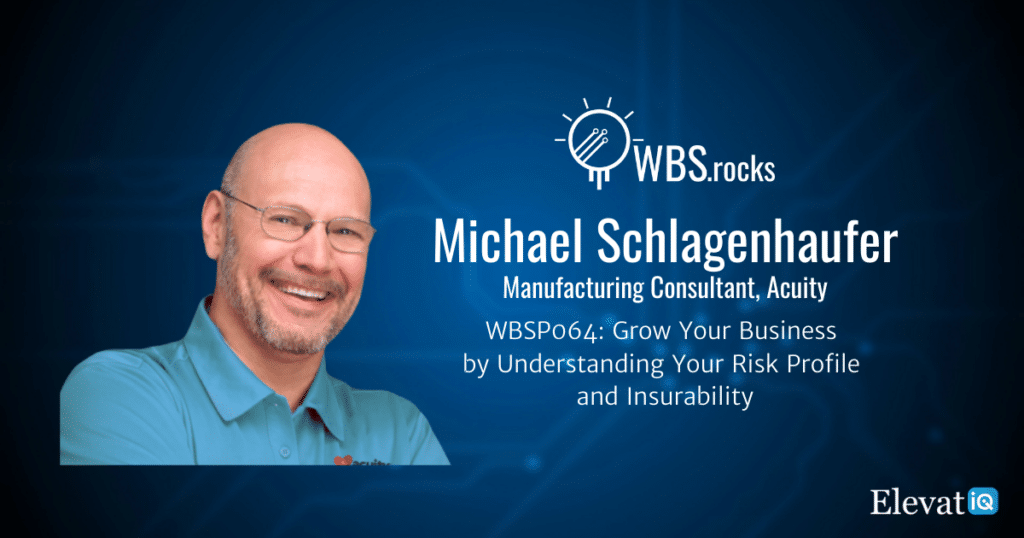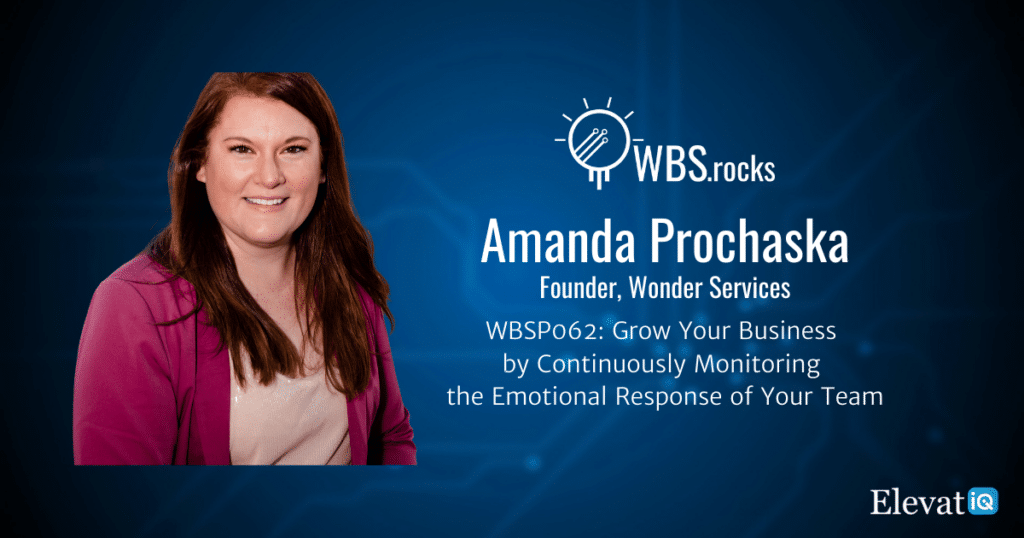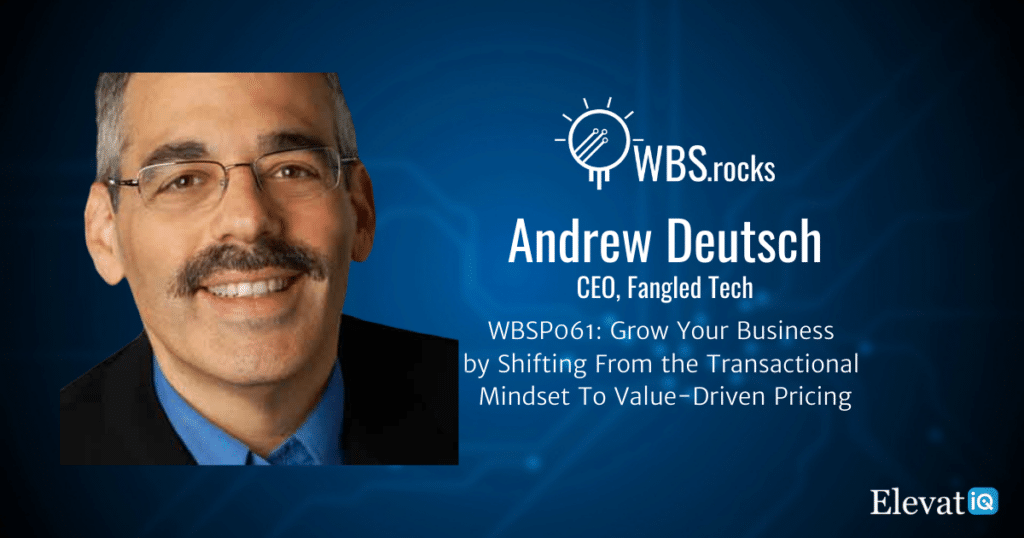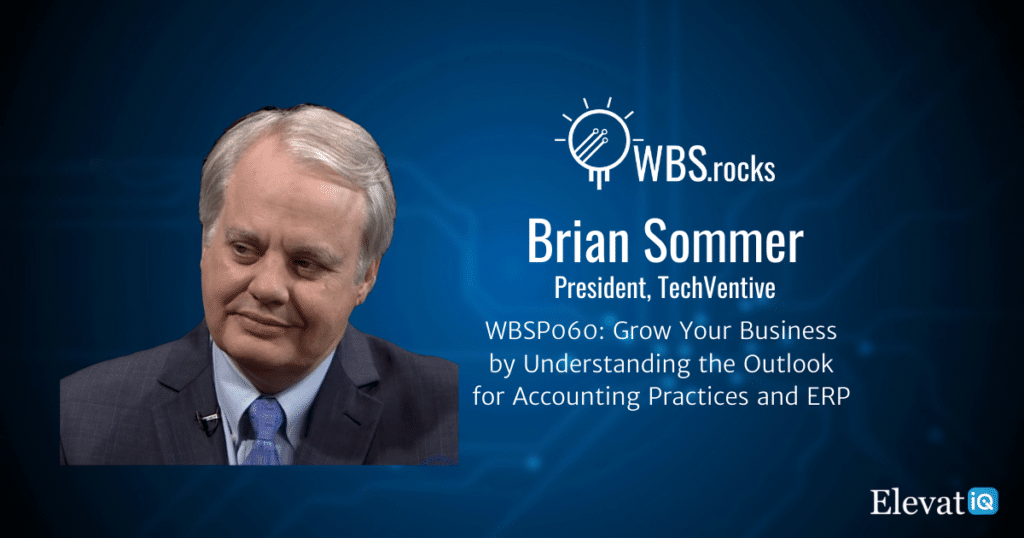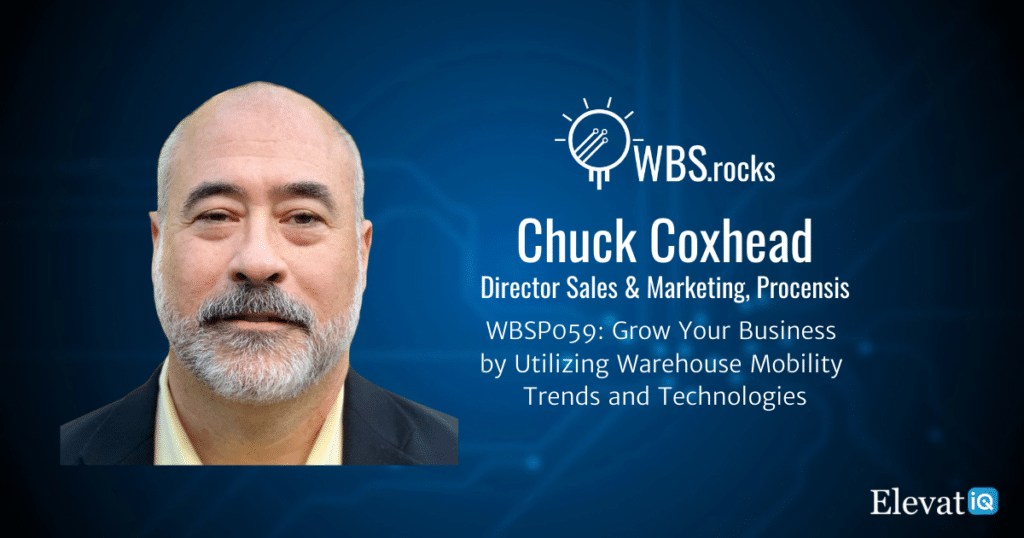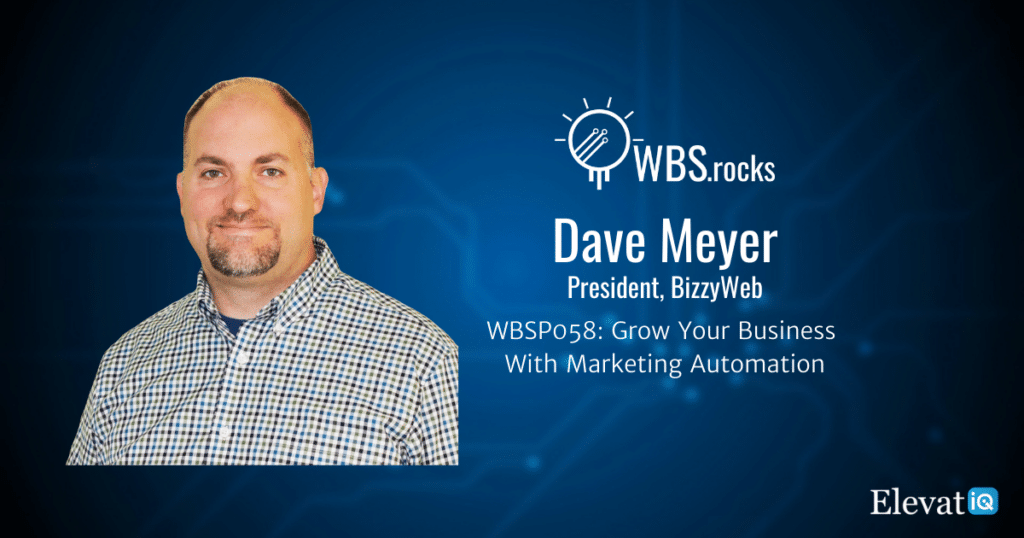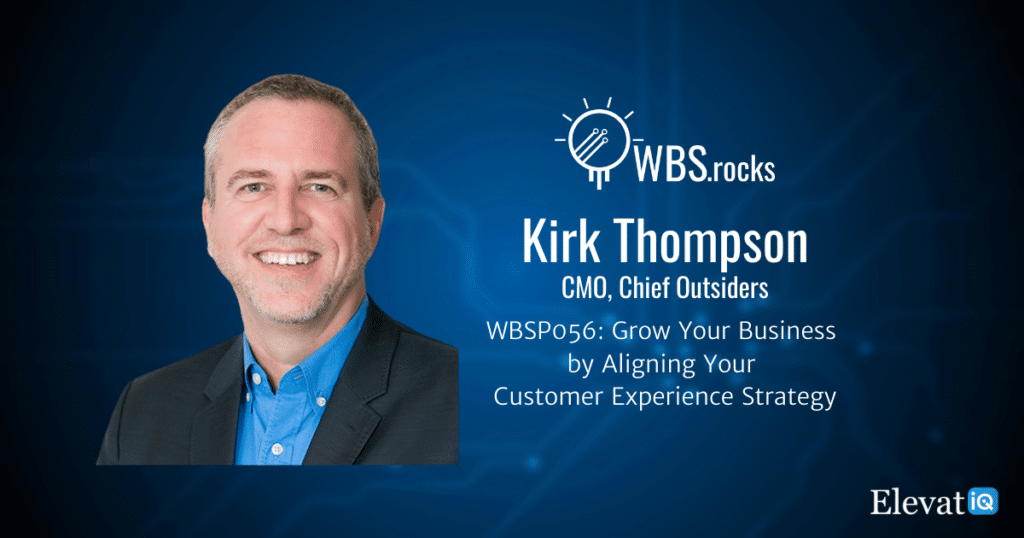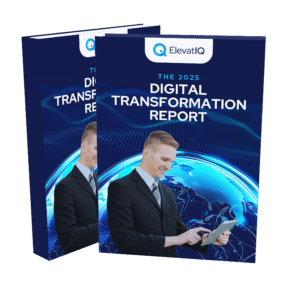WBSP065: Grow Your Business by Understanding the Challenges Associated With Buy Online, Pick Up at Store Model w/ Richard Halter
In this episode, we have our guest Richard Halter, The Wizard of POS, who describes the challenges associated with buy online, pick up at store model. He also talks about why small retailers and manufacturers would need to develop these capabilities to avoid the risk of running out of business because of competitors such as Amazon. Finally, he has described several nuances associated with this model, and the approach retailers can take to implement it.
Chapter Markers
- [0:24] Intro
- [2:18] Personal journey and current focus
- [5:22] Perspective on growth
- [6:53] The challenges of siloed systems in implementing BOPIS retail model for SMB retailers
- [8:39] BOPIS retail model warehouse and retail store architecture
- [10:01] Types of BOPIS retail model with or without retailers
- [12:33] How to start on BOPIS retail journey?
- [15:24] The importance of common data model for BOPIS retail
- [25:24] BOPIS retail system architecture
- [28:26] Closing thoughts
- [29:58] Outro
Key Takeaways
- Retail started with somebody opening up a store, and they’d open a second store and a third store. And pretty soon, they needed a common data model. So they built a silo around that, then they needed a common inventory system. So they build a silo around that. And today, when you look at most major retailers, they’ve got this massively siloed organization, and changing the handle of the buy online pick up in the store model has been an incredible challenge for them.
- Not only do you have to deal with the traditional model, but you’ve also got to deal with the direct-to-consumer model. You’ve got to deal and compete with this little company called Amazon that has got distributors everywhere now.
- The customer order is a liability for the retailer. So if the customer comes in and cancels it, you know you can’t include it in your profit. But once they’ve paid for it and they’ve picked it up, then it becomes part of your profit. It impacts your inventory.
- When something gets sold in retail, and you want to be able to track the sales and what was sold, that comes out of the point of sale system. A company may have up to 40 different systems and vendors. Now every one of those 40 vendors says they have a standard API. The problem is that it’s standard to them.
- In the BOPIS retail model, you might have several POS systems that may participate in transaction along with the e-commerce platform. The challenge is to making sure that all of these systems will be in sync in real-time, or the BOPIS retail option may never work.

Subscribe and Review
Apple | Spotify | Stitcher | Google Podcasts | Deezer | Player FM | Castbox
About Richard
With over 28 years of experience with retail technologies, he is the pioneer of the first online credit card authorization system in 1994. He is the Chief Technology Architect for ARTS system and wrote a book on Retail Technology called “ARTS for Retail.”
He has worked with/trained major retailers and vendors in over 20 countries on 7 continents. They represent over 100,000 stores. He also created a unique iVURM model that cross-connects business strategy to business processes to enterprise architecture to people to business intelligence to retail applications. It is designed to help retailers move into the new agile microservices world by understanding all the potential interconnections.
Resources
Full Transcript
Richard Halter 0:00
The point of sale system interfaces with over 40 different systems in retail. And there is the supply side as well. When something gets sold, and you want to be able to track the sales and what was sold, that’s comes out of the point of sale system. Now every one of those 40 vendors says they have a standard API.
Intro 0:24
Growing a business requires a holistic approach that extends beyond sales and marketing. This approach needs alignment among people, processes, and technologies. So if you’re a business owner, operations, or finance leader looking to learn growth strategies from your peers and competitors, you’re tuned into the right podcast. Welcome to the WBS podcast, where scalable growth using business systems is our number one priority. Now, here is your host, Sam Gupta.
Sam Gupta 1:00
Hey everyone, welcome back to another episode of the WBS podcast. I’m Sam Gupta, your host, and principal consultant at digital transformation consulting firm ElevatIQ.
The lines are blurring between traditional retail supply chains with trends such as DTC and buy-online-pick-up-at-the-store (BOPIS). With large retailers offering such convenience, it’s harder for small retailers to compete. These models require you to have fulfillment centers within 20 miles of the customer location to match the delivery time expectations of consumers. This need drives the business architecture complexity with cross interactions between hybrid systems ranging from POS e-commerce and ERP, which drives the need for an enterprise glue and a common data model.
In today’s episode, we have our guest Richard Halter, who describes the challenges associated with BOPIS retail model. He also talks about why small retailers and manufacturers would need to develop these capabilities to avoid the risk of running out of business because of competitors such as Amazon. Finally, he has described several new answers associated with the BOPIs retail model and the approach retailers can take to implement it.
Let me introduce Richard to you.
Sam Gupta 2:18
He was the pioneer of the first online credit card authorization system in 1994. He is the Chief Technology Architect for ARTS system. It’s a RTS and wrote a book on retail technology called art for retail.
He has worked with or framed major retailers and vendors in over 20 countries on seven continents. They represent over 100,000 stores. He also created a unique architecture model, its IVURM, that cross-connects business strategy to business processes, enterprise architecture to people to business intelligence to retail applications.
It is designed to help retailers move into the new agile microservices world by understanding all the potential interconnections.
With that, let’s get to the conversation.
Hey, welcome to the show. Richard.
Thank you. My pleasure.
Just to kick things off, do you want to start with your personal story and current focus, Richard?
Richard Halter 3:19
Okay, my personal story. Well, I started in 1994, while I was working with secure remote connectivity in the government area, and a company wanted to be able to do online credit card authorizations without having to go through a call center.
And so, I wrote the first online credit card authorization system. And that drove me to a company called McDonald’s because they wanted to eventually have their regional managers know what was going on in the store.
And my background was exactly what they needed. And that got me into the foodservice world. And they sent me over to this group called ARTS, the Association of retail technology standards. They help create inner connectivity standards for use in retail. And that led me to a big chunk of my career. I ended up working over there.
I wrote a book on retail technology and how to interconnect it. I have written and created 40 YouTube videos explaining various aspects of retail technology. I’ve worked with retailers and vendors in 20 countries all over the world. I’ve spoken at major events. I had one big one in Japan. They flew me to Japan for a 15-minute video or presentation. And there were 700 people in the room, and I was told later that the most they’d ever had for that presentation were around three to 400 people.
Richard Halter 4:45
They had a standing remotely and had to turn away people. I think they said they had like 1300 sign up for it, but they had to turn a bunch of them away, and the latest one that I did was just before the pandemic hit. And it was with the Retail Analytics Council in the Chicago area. Yeah. And there I was talking about how do you connect robots to retail applications; the room was full of robotic people. And they had no concept of how to how to integrate their work with the retail technology world. So lots of things.
Sam Gupta 5:22
Okay, amazing. And I’m super excited to discuss all of those things as well, just because, as we all know, retail is changing. And it is changing more with COVID. But before we do that, we have a standard question that we ask every single guest. And that is going to be Richard, your perspective on business growth. What does it mean to you?
Richard Halter 5:44
Oh, that’s a great question. And that’s actually my primary focus today. In all of those videos it’s helping people understand various aspects of where retail is going. And the virus really pushed them over the edge. Retail started with somebody opening up a store, and they’d open a second store and a third store. And pretty soon, they needed a common data model.
So they built a silo around that, then they needed a common inventory system. So they build a silo around that. And today, when you look at most major retailers, they’ve got this massively siloed organization, and changing the handle of the BOPIS retail model has been an incredible challenge for them.
It’s like changing the directions of a battleship versus a speedboat. Yet, when you look at the modern microservices agile world, that’s where you go because now you can change directions in a heartbeat. And that’s what I have actually created a model called IVRUM for an interactive virtual unified retail model to help people move into that area.
The challenges of siloed systems in implementing BOPIS retail model for SMB retailers
Sam Gupta 6:53
Yeah, amazing. So a couple of things from the audience perspective. So with my audience, primarily, Richard is the SMB manufacturers, retailers, distributors. So if we talk about, let’s say, the enterprise world, obviously, they would have a lot more understanding of things like microservices, but in the SMB world, the way the business architecture is going to be, or the system architecture is going to be: for them in just a package.
Okay, that’s how they like to define. So, for example, I mean, they might have a bunch of systems in their architecture, but for the most part, they don’t necessarily have resources, the way enterprise companies would have. So we need to be slightly gentle in terms of the way we describe these concepts for them. So obviously, they are going to be equally impacted by the concept called BOPIS retail. But when we think about this architecture, especially from the SMB perspective, how do you see the siloed information or siloed systems being a barrier for this business model?
Richard Halter 7:56
Well, that’s actually a great question. Because with BOPIs retail, time is of the essence. Somebody wants to call in the morning, and they want to pick up something in the afternoon. And that means that the ability to deliver items to the customers directly, to the consumer in some aspects, is absolutely critical.
And that changes the manufacturing side of this; it moves their ability to supply the retailers closer to the retailer, so you no longer ship it from somewhere 1000 miles away. You’ve got to be able to ship it from somewhere 20 miles away. And that’s a huge impact on the entire manufacturing distribution world.
BOPIS retail model warehouse and retail store architecture
Sam Gupta 8:39
So yeah, so that’s a massive shift, I would say in the warehouse architecture, the way I like to think about it, right? So let’s say if you are saying that everything needs to be 20 miles away, and if you look at it from the cost perspective, obviously I’m not going to be opening my house or a retail store unless I have demand in that specific area. Right? So how do you see this changing for the retailers or distributors? How should they be planning this shift in terms of changing their overall retail store architecture or the warehouse architecture?
Richard Halter 9:12
Well, that’s not just the warehouse. The difference between the warehouse and the supply side is getting really tight, you know, bigger stores and bigger companies have warehouses. They can move closer, but smaller companies don’t.
So they have to get this stuff directly from the manufacturers or their wholesalers or wherever. So it’s not a clear cut line between what like it used to be, or the manufacturers would sell it to somebody, and then they would distribute it and all that it’s gotten to where you almost order immediately, and I was starting to talk about the direct to consumer is a whole new thing because the consumer themselves are ordering directly from the manufacturer. So the manufacturer can be an integral part of the BOPIS retail model.
Types of BOPIS retail model with or without retailers
Sam Gupta 10:01
So if the consumers are directly ordering from the manufacturers, and if a retailer is going to be involved in that interaction, is the distributor going to be involved in that interaction, my understanding of that model is that you order directly from the manufacturer, the manufacturer is going to ship it as well. So then the retailer and distributors are not involved in that interaction at all, right?
Richard Halter 10:21
There are two ways to look at that. Yes, the general way to look at it is the retailers themselves won’t be directly involved. But there are models for the retailers as they provide a direct connection to the manufacturers. So you as an end consumer may not even realize that you’re ordering it from the manufacturer.
Sam Gupta 10:39
Right. So let’s talk about some examples. So let’s say I have a story. And obviously, we work with a lot of different retailers in the D2C model as well. So let’s say if I have my retailer, and they are manufacturer as well, of the food products, and what they are doing is that they are slightly smaller, maybe 10 to $20 million is the revenue that they are getting, and they are very localized in their services because they might have their own fleets that they might be utilizing to be able to deliver the food item, since they are in the frozen food space, right.
So if this is the case, now these consumers are going to be ordering directly from the manufacturer. And they are going to expect, let’s say, the shorter the time frame. So in the traditional model, even if you have, let’s say, five days to fulfill the order, that may be okay.
But with COVID, I think you are going to have a sort of lead time in terms of the ordering of the product. And you mentioned estimates at the beginning of the conversation as well. So how do you see the overall architecture or the warehouses or the stores tinting in this particular example?
Richard Halter 11:49
That is it’s gonna be a mess,
Sam Gupta 11:51
Okay, that’s what I like to hear. Tell me more.
Richard Halter 11:55
Not only do you have to deal with the traditional model, but you’ve also got to deal with the direct-to-consumer model. You’ve got to deal and compete with this little company called Amazon that has got distributors everywhere now.
And so it’s no longer a nice, safe, clean dividing line between the manufacturers, in the end, the retailers, and even the customers. It’s all becoming one. The world is becoming a customer-driven world, no longer a retailer. So if the customer wants something, they want it, and they want it as quickly as they can get it. And so, the speed is becoming of the essence on this.
How to start on BOPIS retail journey?
Sam Gupta 12:33
Okay, so let’s say if I have a retailer who has never explored BOPIS retail model. So what are the changes they can expect in the overall architecture to be able to deliver this? So let’s say if I’m a traditional retailer, I’m simply selling in my local geography. I may not have my e-commerce portal right now. I may not have much of the traffic from the ecommerce perspective. So tell me how the architecture needs to be designed or aligned so that I can serve my customers in the new model.
Richard Halter 13:08
Okay, there’s a model out there called a CQRS. And it stands for the ability to take two data models; one data model contains information from each retail transaction that gets summarized into the second model. And I’m getting kind of geeky here.
But that’s kind of a key thing there. One of the big problems with BOPIS retail is when you get to the store; you decide you want to buy something that’s in the store itself. So now you’ve got a separate transaction that you want to you as a customer want to play with when you pick up the online component. So how do you manage to merge all of that stuff together? And that’s the heart of this, the CQRS model?
Sam Gupta 13:52
Yeah, tell me more about the CQRS model. I get the gist of it. But I mean, break it down for our CFO. Describe to me why a CFO should care for it, what is going to be the advantage if I tried to implement it in my organization, and what are going to be the business benefits?
Richard Halter 14:10
The beauty of it is you have like I said, two data models. One data model has every transaction uniquely entered into it. The second data model summarizes the ones that are related to one final transaction.
And when the customer comes in and pays for their items and picks up the items. The second transaction model gets turned into a retail transaction, which is where you actually count your profit when it’s in the second model is called a customer order model. The customer order is a liability for the retailer. So if the customer comes in and cancels it, you know you can’t include it in your profit. You don’t have to pay taxes on it and all those kinds of things.
But once they’ve paid for it and they’ve picked it up, then it becomes part of your profit. It impacts your inventory. It impacts your sales and all of those kinds of things. And, of course, your customer information is a huge part of that as well. So there are actually, in effect, three steps to it. The first step is all of the individual transactions, no matter where they’re sourced from. The second step is summarizing those into a single one. And then the third step is when you actually get to account for it.
The importance of the common data model for BOPIS retail
Sam Gupta 15:24
So help me understand these data models a bit more. Again, I’m a CFO. I’m not very technical, right? So in my case, let’s say if I look at my business, I’m probably going to have a Shopify that I keep hearing from my technical team that they are using for the store.
So that is my sort of ecommerce world. I have a bunch of POS systems in each of my stores, and then I have my accounting system, QuickBooks. Okay, so let’s say if I’m utilizing these systems, what data models are you referring to? Are you referring to, let’s say, the POS data model? Are you referring to the ecommerce data model? Or the accounting system data model? What is the data model here?
Richard Halter 16:02
Okay, that’s a fascinating question because the answer is yes to all of the above. Okay, the data model that I’m really talking about is the data model that actually started the Association for Retail Technologies way back in 1994. That model has been built up for over 25 years now. And it has a model for the entire retail operational side. It has somewhere around 8000 attributes in it. So it’s really extensive. And it acts as an enterprise model. When you look at let’s take a company like Yum Brands, Yum Brands has five different concepts.
But now I’m the CEO of Yum Brands. How do I know what my overall sales are? Well, you have to be able to bring those five data models, the data from them, bring it into one enterprise model, and then you can do your analysis and decision making based on how the company is doing. So that’s the standard retail model that I was talking about. It is an incredible model if you haven’t seen it,
Sam Gupta 17:17
I understand that it is incredible. But I’m actually trying to understand how it is going to be relevant for me, let’s say if I’m the SMB retailer, right? So in my case, let’s say when you talk about the data model, I feel that that’s the job of my technology people and the ERP provider that is working with me. They tell me that they have enough business scenarios to be able to support.
So again, going back to my question, should I care for the data model and, based on that, select my systems? Or should I look at my systems currently and see which are the data models that are supported by the standard that you’re describing? So that I’m sort of defining the architecture in a way that is compliant with the retail standards? It seems like a chicken and egg problem. So tell me, what comes first? Is the data model that is going to come first that is compliant with the retail business standard? Or shall I leave this to my ERP and POS provider and let them figure it out?
Richard Halter 18:18
That’s a great question. That’s actually a really great question. They the thing that most people don’t realize is that an application in retail, let’s take the point of sale because that’s an easy one. Yeah, the point of sale interfaces to over 40 different systems. In retail, there is the supply side as well.
When something gets sold, and you want to be able to track the sales and what was sold, that comes out of the point of sale system. Now every one of those 40 vendors says they have a standard API. The problem is that it’s standard to them. So we regularly see things like one company calling something they sell an item, and somebody else calls it a good or service or something like that. The problem is, do those two things match? And in addition to that, one of them may break it apart from different from the other one.
Richard Halter 19:13
And so, being able to tie those two together in order to figure out what’s going on. And for the CFO position, it is an enormous challenge. And on the supply side, being able to understand that those two different things are actually the same thing with just a different name on it.
So it’s an enormous problem that the standard model actually helped solve because everything’s called an item. And the beauty of that is when you get outside of retail, and you start looking at connecting into other areas like you’re selling medical, you have doctor visits, it’s your store.
Richard Halter 19:53
Well, it turns out that doctors actually have the same retail model as the retailer does. In essence, outside of medicine, for example, they track inventory and customers. They locate items. And they have associates that work for them.
So that’s exactly the same as the retailer has. The difference is that their items are medicine rather than bread or shirts. And I actually found this out, I was at a doctor’s appointment, and he was describing his business to me when the light bulb went on. So fundamentally, any company that sells anything, if you sell motorcycles at your store, those are items.
Now they have different sets of attributes to them. But fundamentally, they’re the same. So you could actually take a standard model and expand your company to do things that are outside of what you traditionally do and do it easily.
Sam Gupta 20:53
Okay, amazing. So I’m still not sure if I follow this completely, from my perspective, because I’m trying to figure out as a CFO of the SMB organization if I should care for this, if this is going to be relevant for me or not.
So let’s see if I try to unpack this a bit. So in my case, I have the POS system, I have my ecommerce system, I have my ERP system. So based on the way you describe my understanding of this is going to be that let’s say, if my POS system recognizes an item as a different item, or they use a different word for it, then the POS system is probably going to have a problem talking to let’s say the ecommerce system, or e-commerce system is going to have problems talking to ERP system, hopefully, I mean, this is the simplistic architecture, right. And let’s say if I’m using 15 different tools, they all are going to be speaking their language. So obviously, there is going to be a communication problem.
Sam Gupta 21:41
And now, if we are trying to explore BOPIS retail model, then obviously, I will not be able to meet the timeline that you had mentioned towards the beginning, just because of this communication problem, because everybody’s trying to speak different languages inside the system landscape. Right?
So again, am I talking to these companies that whether they are compliant with the standard that you are trying to advocate here? Or am I simply going to be looking at the standard to make sure that they are able to communicate? So tell me a little bit more about why I am caring for these standards.
Richard Halter 22:20
If you have to go through the conversion routine, you impact the speed at which you can track your money. You can track what you sell and how you pick up, and so it slows down. It used to be that. Now let’s talk about taxes. We used to pay taxes on a yearly basis. They moved it down to a quarterly basis. Now it’s down to a monthly basis.
Some people are doing it on a weekly basis. You have the same issues with your profit. You want to be able to turn money around. I mean, think about this whole Coronavirus thing and its impact on cash flow. Many companies have gone under. Several 100,000 have gone under simply because they don’t have the cash coming in.
Because it takes too long from the point that they make the sale until they get the money so they can turn it around and buy more things to sell. That whole cash flow process is critical. And the smoother and easier it is, the better it is for the retailer and even for the manufacturers because they need to have money to buy the stuff they use to build their products.
Sam Gupta 23:27
Okay, Richard, do you have any stories that you might be able to narrate here with respect to the work that you have done and typically, what I like to see in the story is if you have worked with a customer, what kind of challenges they had while exploring BOPIS model and obviously they did not have in the beginning.
And then what changes you made to the process so that they were able to perform these transactions and the KPIs that you were trying to add. And then finally they were able to meet their goals. So tell us some of these stories of your work.
Richard Halter 24:01
Okay, there’s one that I really liked to tell because it’s probably the best example of everything. I went to a company called Metallics. And they were building a new point of sale system. This is when 2010 and I went there and showed them how to build what is now called an agile microservices architecture using all of these various standards.
They showed up at the National Retail Federation show showing this new point of sale system that I had architected for them as they were so successful that it’s with NCR now. It’s called Emerald system at NCR, and it was the first one where when you showed it at the store, I mean at the show they walked up, and they had a tablet, and you order something off of the tablet. So you’re now buying online.
Richard Halter 24:52
He walked over to the point of sale system, and you added a shirt to it, so now you’re adding an online, I mean in-store component to your online purchase, they went over to another point of sale system. And that’s where they paid for it.
So that’s where the credit card system was. And finally, you went to a third one. And that’s where you actually received the items. And so they had this fully dynamic, fully flexible system that was built up natively following the model that I helped them build in 2014.
BOPIS retail system architecture
Sam Gupta 25:24
Okay, and what were the challenges in building this model? My assumption here is going to be that you have some sort of centralized database.
And that’s how you are able to process these transactions from POS one to POS two, to POS three, right? So what was the underlying glue that was enabling this transaction? Was this a custom-built layer from the microservices perspective? Or was it some sort of ERP system that you were utilizing?
Richard Halter 25:49
Now, as part of the retail technology standards work, and really what got me involved in it was being able to define standard messages. And one of the standard messages was a point of sale message. One’s on a customer. One’s on an item. And so now back to the talking a common language. Everybody uses these messages to communicate back and forth.
And again, since everybody’s using the CQRS model, each of these messages went into the first data model and got summarized up into the second model. And that method that you could take them, there’s one message called POS log. And my title is The Wizard of POS. So The Wizard of POS helps them understand how to interconnect all of this stuff using the standard messages as part of the framework.
Sam Gupta 26:48
Tell us a little bit about this message. So let’s say if I have my POS system from either the NCR or the IBM, or the Square or whichever POS system you are using, so are they going to be compliant with, let’s say, the CQRS standard? Shall I be asking them? If Are they compliant with that? If not, am I customizing the POS system to make sure that you know they are complying with the CQRS message?
And also, I mean, are the retailers going to use some sort of either the warehouse management system or the ERP system underneath? Are they compliant with the CQRS standard? Or do we need to make them compliant with the CQRs?
Richard Halter 27:23
Actually, the CQRS standard is the end repository. What they really need to be focused on is the interface standards. And you’ll find that the POS log standard I was just talking about is very widely adopted worldwide.
And it is the message that should come out of the point of sale system, and most of them do. Most of them have that coming out. And that’s the one that uses the interface with the transactional component of the CQRS model. So these are the standard messages.
There are over 40 different standard messages for everything from the retailer side to the vendor side. In addition, GS1 has got some of the standards that deal with actually communicating to the manufacturer, so the UPC codes, for example, are their standard. And so it’s not the CQRS that’s the key for the point of sale people. It’s more the message interfaces and being able to use a common language.
Sam Gupta 28:26
Okay. All right. Do you have any other stories that you would like to share with you?
Richard Halter 28:29
Well, I just finished working with a company in South America. They’re the largest retailer down there. And they were upgrading their point of sale system, and they wanted to go to this standard message model.
And so they had me come down and show them how to convert the message out of this point of sale system to the standard model because they wanted to have the same message coming out of their point of sale systems across all of South America. And they’ve got something like 1600 Costco size stores down here. It’s an enormous thing. And they just rolled it out of Chile. So it’s starting to be rolled out across the entire South American continent.
Sam Gupta 29:13
Okay, do you have any last-minute closing thoughts? That’s it for today, Richard?
Richard Halter 29:16
Yeah, the BOPIS retail model is greatly supported by the microservices world. And one of the videos that are out there on my YouTube channel talks about how to move into these microservices because I only touched on the top part of that, the details on how to make it all work. It’s really pretty amazing, and it’s all there for you to take a look at.
Sam Gupta 29:38
Okay, amazing. And my personal takeaway from the conversation is going to be the BOPIS retail model may look simple at the surface, but it’s much deeper and complex. So do your research before you start implementing that. On that note, Richard. I want to thank you for your time. I appreciate your insight.
Richard Halter 29:56
Thank you for asking me
Sam Gupta 29:58
I cannot thank our guests enough for coming on the show for sharing their knowledge and a journey. I always pick up learnings from our guests, and hopefully, you learned something new today. If you want to learn more about Richard, head over to GlobalRetailTechnology Advisors.com. Links and more information will also be available in the show notes.
If anything in this podcast resonated with you and your business, you might want to check out the related episodes, including the interview with Paul Sklar, who takes us through the retail industry’s deep dive. Also, the interview with Chase Clymer, who brings a unique perspective for manufacturers and ecommerce merchants from his experience of helping customers getting their ecommerce businesses to grow from the ground up.
Also, don’t forget to subscribe and spread the word among folks with similar backgrounds. If you have any questions or comments about the show, please review and rate us on your favorite podcasting platform or DM me on any social channels. I’ll try my best to respond personally and make sure you get help. Thank you, and I hope to get you on the next episode of the WBS podcast.
Outro 31:05
Thank you for listening to another episode of the WBS podcast. Be sure to subscribe on your favorite podcasting platform so you never miss an episode. And for more information on growth strategies for SMBs using ERP and digital transformation, check out our community at wbs.rocks. We’ll see you next time.

